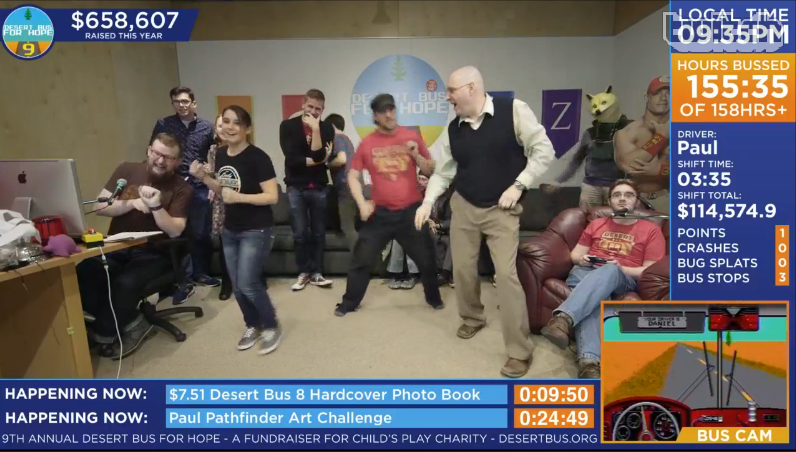It may be the most unorthodox fundraiser in British Columbia – and one of the most effective.

For the past seven days, a group of comedians and gamers in Victoria have been playing the “worst video game” ever in a non-stop online telethon.
And they raised over $675,000.
“It’s hugely exciting,” says Graham Stark, one of the organizers of Desert Bus for Hope, the annual event which has set a record this year.
“We really weren’t sure that we were able to surpass last year. We say that every year, and we keep being surprised. Eventually we have to hit an equilibrium, but it didn’t happen this year.”
The game they play is Desert Bus, an unreleased minigame for the Sega CD in 1995. Players drive a bus in realtime from Tucson to Las Vegas at a maximum speed of 45 miles per hour. There is no traffic, no passengers, the bus constantly veers slightly to the right, and the player must drive the bus for eight hours straight without crashing.
Since beginning the annual event in 2007, over $3 million have been raised.
“What we like about Desert Bus is we can safely claim it’s the most boring video game ever made. It is even to people who don’t understand video games, it is clear a misery to play. But it allows us to the freedom to do a bunch of entertaining stuff,” says Stark.
- White Rock fatal stabbing suspect and victim may have been in physical altercation: IHIT
- High-profile B.C. sex offender Randall Hopley pleads guilty to 3 charges
- BC Hydro offers free AC units to lower-income, vulnerable customers
- B.C. to ban drug use in all public places in major overhaul of decriminalization
“We don’t have to be heads down focused on the game at the time, because it is so boring, we can do other things to entertain the viewers at the same time.”
All money raised goes to Child’s Play, a Seattle-based charity that donates toys and games to children’s hospitals – including BC Children’s Hospital – across the world.
“Child’s Play is touching the lives of millions of children, and Desert Bus is our biggest fundraiser of the year. It’s really incredible and makes a massive impact,” says Jamie Dillion, program manager for Child’s Play.
“Studies are starting to show that their morale actually impacts their rate of recovery. If I come into a room with a hospitalized child, and I have an iPad and a shot, and I say ‘you can play Minecraft on your iPad, but I just have to give you this shot really quick,’ the kid’s aren’t going to notice that shot.
“If kids are able to interact with a game, they notice less pain. We’re not just letting kids be kids, we’re helping kids heal.”
The yearly event has grown from a quick fundraiser, created on a whim, to a week-long activity watched online by thousands that requires over 60 people to plan and implement.
“The inception of the fundraiser was we wanted to do a silly marathon with Desert Bus, and we wanted to find a way to raise money for Child’s Play. The reason we keep doing it is because it does so much good,” says Stark.
“We absolutely never thought it would reach this level. We set our goal in the first year at $5,000. In our minds, was a shoot for the stars goal…and we raised over $22,000. We don’t have a grasp of numbers. All the money we’re raising, it doesn’t seem real until we think about all the good we can do,” says Stark.
Desert Bus for Hope 9 was scheduled to wrap up at 9 p.m. Friday night—but additional donations meant it continued for another four hours.
Which meant tens of thousands of more dollars for games and toys in children’s hospitals across North America.
“The reason is it’s successful is people’s combination of generosity and spite. The more people donate, the longer we play for,” says Stark.




Comments